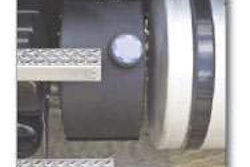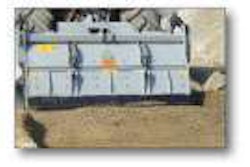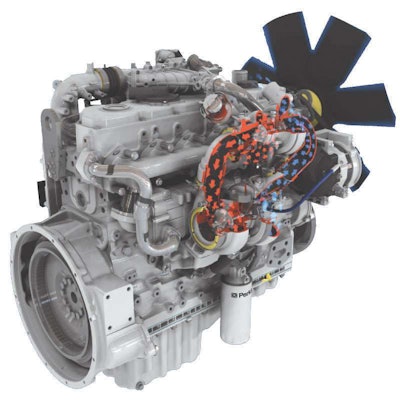 Perkins 1200 series Tier 4 Interim engines have two turbochargers as indicated by red and blue arrows for fast operator response, increased power and torque and reduced fuel consumption.
Perkins 1200 series Tier 4 Interim engines have two turbochargers as indicated by red and blue arrows for fast operator response, increased power and torque and reduced fuel consumption.PERKINS
A three-year head start in the emissions game has given Perkins time to explore and develop a wide range of Tier 4 technology.
By Tom Jackson
For most medium and large horsepower bands the new diesel emissions regulations kick in starting in 2011 and 2012, and the factories are tooling up the new designs as we speak.
But 2008 was the watershed year for manufacturers with smaller engines in their lineup, including Perkins. That was the year all engines 25 to 74 horsepower had to meet Tier 4 Interim and engines smaller than 25 horsepower had to meet Tier 4 Final standards.
Perkins offers engines from as small as 12 horsepower to as big as 300 horsepower. And since 2008 the company has produced more than 200,000 engines meeting the Tier 4 Interim standard under 75 horsepower and Tier 4 Final regulations for engines less than 25 horsepower. With that early experience under its belt, Perkins found that the emissions regulations were best addressed by using a variety of solutions that took into account not just horsepower, but cost, complexity and customer needs.
Collaboration brings benefits
As an engine-only manufacturer, Perkins had to satisfy the needs of its hundreds of OEM customers and their thousands of different application requirements. A tall order, which was met by inviting their customers into the design process early in a series of what the company called “technology integration workshops.”
Perkins hosted its first integration workshop with customers back in 2007. The main focus of the workshops was to be able to find room for the exhaust after treatment technology and increase performance standards in addition to making everything fit in the same footprint as previous engines.
Perkins also used the process as an opportunity to rethink all the aspects of their engines, not just exhaust emissions. “A lot of the changes were around customer issues, things like quality, reliability, performance and fuel economy,” says Allister Dennis, marketing manager, at Perkins. “We also looked at introducing biodiesel capability and make sure it’s acceptable for the life of the engine. We got to B20 with no impact on quality or reliability.”
Simple NOx control
To get NOx (oxides of nitrogen) levels down in bigger engines is a challenge, but for the smaller horsepower bands and 2008 regulations Perkins used a simpler solution. “We just changed the phasing of the valve actuation and timing to retain just a bit of the exhaust gas in the cylinder,” says Dennis.
It’s a less complex solution than EGR (exhaust gas recirculation) but based on the same principles. “NOx is nitrogen and oxygen combined,” Dennis says. “The less oxygen you put in the cylinder to start, the less NOx you create.”
By reducing the volume of gas exiting through exhaust valve it allows enough low-oxygen exhaust to linger in the cylinder and cuts NOx levels. In bigger engines the exhaust gas is captured and recirculated back into the intake air – equally effective, but it requires additional plumbing to route the gasses back into the engine and adds componentry.
Perkins also stayed with mechanical fuel injection for its Tier 4 Interim engines under 75 horsepower. Mechanical fuel systems are less expensive than electronic fuel injection and according to Dennis, more fuel tolerant – meaning they are less likely to be fouled by contamination and more forgiving when using biodiesel or jet fuels at airports.
Many applications call for electronic fuel injection, however, and Perkins offers this as an option in the smaller horsepower ranges. “Sometimes you may want to control the engine remotely, such as an aerial lift, and there it makes sense to use electronics,” Dennis says. “But for applications like a compressor that sits there all day just doing its work we stick with mechanical control.”
Bigger engines, more technology
From 75 horsepower and up Perkins is deploying electronic controls, high pressure common rail fuel injection and DPF (diesel particulate filter) and DOC (diesel oxidation catalyst), Dennis says. It also uses Perkins’ ‘NOx reduction system’ (a form of EGR).
When the company was evaluating the merits of different technologies it discovered it could meet the emissions regulations with a DOC and muffler only and not a DPF. But it chose the DPF route because a DOC-only arrangement limited the engines’ transient response, fuel economy and power density, whereas the DPF gives a low cost of ownership and integrates well into a variety of applications. “We weren’t satisfied our four cylinder could deliver 174 horsepower with just a DOC,” Dennis says, “while giving the level of performance and fuel economy our customers wanted.”
Cleaning out soot
DPFs accumulate small amounts of soot over time, which has to be burned out of the unit by hot exhaust gas. This happens naturally anytime the exhaust temperatures exceed 482 degrees Fahrenheit aided by a catalyst of precious metal in the filter. Perkins calls this process low-temperature regeneration.
On engines that idle much of the time, or in extremely cold temperatures or on engines bigger than 174 horsepower, low temperature generation may not be sufficient. So Perkins supplements the low temperature regeneration with a high-temperature system – either a mechanical device that momentarily boosts the heat in the cylinder or a burner that heats the exhaust gas to more than 1,112 degrees Fahrenheit, directly oxidizing the soot.
DPFs also collect ash over time, which needs to be cleaned out by removing the unit and vacuuming out the debris. The EPA requires that the first ash service should come no sooner than 3,000 hours for engines less than 175 horsepower and 4,500 hours for engines above that. Perkins has been able to avoid ash clean out completely for some of its engine range, providing further low cost of ownership.
Cooling not a problem
One thing that didn’t change much at all was the size of the cooling packages. EGR engines tend to reject more heat but Dennis says Perkins found coolant temperatures were in most cases increasing only by single digit percentages.
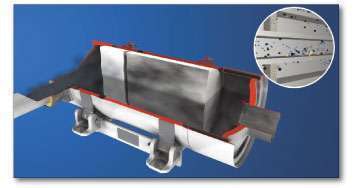 The diesel particulate filter traps soot on the porous ceramic filter material, leaving exhaust gasses clean.
The diesel particulate filter traps soot on the porous ceramic filter material, leaving exhaust gasses clean.Likewise with the charge air coolers. “We were pleased to find that we weren’t putting more heat into the engine,” he says. “In the balance our cooling packages are not going to be particularly bigger and many OEMs may find their existing cooling package is fine. That’s working out well.”
Choices change performance
Perkins established three goals it wanted to achieve when it settled on its Tier 4 Interim and Final technology solutions: increase power density, improve fuel economy, and ramp up the transient response and load acceptance.
Power density was critical to create smaller engines with equal or better performance than their predecessor. This ensures there would be plenty of room for exhaust after treatment systems, including the technology for Tier 4 Final regulations in mid-decade. The 850 Series engine is getting up to 40 percent more power than its predecessor; the 4.4-liter 1204 engine gets 30 percent more power and the 1206 gets 10 to 15 percent more, Dennis says.
When you get more power from a smaller engine, fuel economy goes up. This is important to OEM customers who want to sell low cost of ownership machines. But also, if the next regulatory regime after Tier 4 Final becomes the regulation of carbon dioxide emissions, then fuel economy will play an increasingly important role.
To get the transient response they needed, Perkins went to a twin turbo configuration in the 1204 series engines above about 140 horsepower and above 175 horsepower on the 1206. “With the twin turbos, the small one gives you really quick response at low speed and then the larger turbo gets you the power at the top end,” Dennis says. This improves the engine’s ability to respond quickly when a load is put on it and keeps productivity high.
A look ahead
Perkins is now beginning to talk to its customers about how to best handle the Tier 4 Final technology. SCR is a likely technology for the company, but precise technology combinations are still to be confirmed.
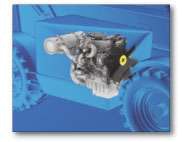 The Tier 4 exhaust aftertreatment system is configured so as not to significantly alter the size or shape of the machine’s sheet metal or interfere with operator sightlines.
The Tier 4 exhaust aftertreatment system is configured so as not to significantly alter the size or shape of the machine’s sheet metal or interfere with operator sightlines.“We’ve already been working with our customers to reserve space for any SCR after treatment system,” Dennis says. “We’ve got a pretty good head start there and we are now working our Tier 4 Final customer conversations to optimize our solution and our customers’ installation at Tier 4 Final above 75 horsepower, which starts in 2014. This is an exciting time for the industry and Perkins is enjoying the challenge.” EW




